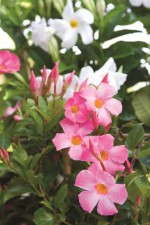Tropical Plants Mean Bold Color And Big Sales

Tropicals offer growers and retailers a huge opportunity to extend the spring growing season and sales into summer with bright, bold plants that will keep gardeners coming back for more. Increased breeding in this category, coupled with growing consumer interest, makes tropicals an exciting growth area.
Historically, tropicals have had two major challenges, according to Allan Armitage, horticulture professor at the University of Georgia, who says tropicals for the landscape should instead be called “plants with a tropical look,” so as not to be confused with indoor plants.
“First is cost,” Armitage says. “Plants like taro or ginger are large and not easy to propagate in numbers. They have to be from tissue culture, so preproduction to get to the plug stage is expensive. Second, they require heat to grow, so a greenhouse in Ohio isn’t going to be able to grow them economically for when they’re needed in the spring. Breeders need to work toward developing plants to stand the cooler, northern greenhouse environment.”
While climate poses a problem selling tropicals for spring in the north, the advantage is opportunity for late spring and summer sales, when the garden center is mostly empty, Armitage says.
“There is such a push to produce everything in the spring, but when you go to the garden center in the summer, there’s nothing to see but leftovers,” he says. “These very colorful, bodacious plants can be grown in containers, and by summer they’ll be spectacular.”
More Than Leaves
Containers are just the trend that ForemostCo is aiming for with its efforts in the Thrillers (sanseveria, dracaeana), Fillers (crotons, syngoniums) and Spillers (hedera, Pothos) line, says Randy Natalino, vice president of marketing.
“We need to extend the season; everyone can sell in April and May, but for the economic health of our industry and for interest in our plants, we need summer plants,” Natalino says. “Many types of foliage coming from Central America are well adapted to summertime patio use in the U.S. and Canada. They add lots of color and interest at a relatively low cost. Because they are used in May, June and July, they are doing well in traditionally cooler climates.”
ForemostCo is also promoting semi-tropical products that look tropical but can do moderately well in colder temperatures, including Cordyline australis ‘Red Star.’
Building Flower Power
Also adding more flowers into the mix, Hort Couture will offer a new line of Patio & Garden Orchids, which are durable, can tolerate being mixed with other summer annuals and have summer-long flower power. The brand also continues to see growing demand for its mandevilla Pergola series and hibiscus Ingenue, because as Monroe says, with consumers, it’s all about bold color.
“Tropicals are brilliant colors and bold textures that you just can’t get from other plants,” he says. “The huge leaves of alocasia ‘Elegant Elephant’ or the overpowering color of hibiscus ‘Ingenue Electric Blue’ are irresistible to the consumer. As a centerpiece for a mixed container, they give scale and lushness that the consumer perceives as value.”
Reinventing Genera
What began as a quiet nursery niche ended up an explosion of popularity for Suntory Flowers’ Sun Parasol mandevillas. A new group, Garden, will launch this year.
“In all our breeding, we are going for stable colors, ease of growing and uniform habits and flowering,” says Shigeru Sarada, Suntory’s managing director. “In addition to performing for growers, the plants must provide a lasting value to the end consumer.”
With even better market penetration in Europe as the Sundavilles, Sarada says he feels there is still untapped potential in North America. Thanks to large growers like Costa Farms and major retailers getting behind the Sun Parasol brand, Suntory has created dramatic growth in mandevillas. Additional Sun Parasol branded pots are also coming in 2012.
Suntory’s next goal is to overhaul bougainvillea, Sarada says. This tropical is a favorite with consumers but difficult to manage in the garden or present as a tidy potted plant. Suntory introduced the Sunvilleas last year. They’re miniature plants that bloom immediately, even as liners.
Breakthroughs On The Horizon
PlantHaven is working with breeder John Cho at the University of Hawaii on breakthrough foliage and branching plants that quickly fill a container. According to Fran Setbacken, PlantHaven’s marketing manager, Cho has exciting new varieties of colocasia that will be showcased at the California Spring Trials. Cho is also working on advanced breeding in other tropical plant genera, specifically focusing on disease resistance, invasiveness and plant hardiness.
“The colocasias from the university are very disease resistant, as virus has been largely eliminated,” Setbacken says. “This gives plants their vigor.”
Time For Vines
Even more advancements are coming from Athena Brazil by way of a new line of tropical vines. Forty varieties are enduring testing. Paul Gaydos says between 10 and 15 will likely be introduced at Spring Trials.
Athena Brazil has introduced several new tropical varieties already, the most notable including alamanda ‘Brazilian Red Wine,’ clerodendrum ‘Starshine’ and orthosiphon ‘Lilac Splash.’ Most of its landscape tropicals are part of the Landscape Elite line, which Gaydos says is “the best of the best for landscape items.”
“The biggest issue we face is in shipping,” he says. “Most of these types of plants do not like to be in a box for very long. To overcome this, we started to callus more and more varieties so they ship better and root faster for the growers.”
With its focus heavily set on vines, Gaydos predicts Athena Brazil will continue this line of breeding for years to come.










